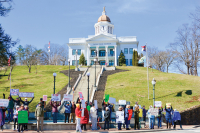New model for mountain living
Mixed-use developments where residents live, work, shop and dine within a few block radius are popping up in cities around the nation, but have been slower to take hold in the mountains of Western North Carolina. One Macon County developer is aiming to bring the concept of mixed use to the mountains by turning a 22-acre parcel of land near downtown Franklin into a community where cars are hardly needed and everyone knows your name.
When it’s all said and done, Sanctuary Village will feature 150 residences in a variety of styles, from single-family homes to condos to live-work spaces. The development will have its own store fronts, as well as access to a grocery store, restaurants and a hospital all within a half mile in greater downtown Franklin.
“This is an in-town, urban neighborhood, much denser than what people are used to in mountain communities,” said Ben Brown, spokesman for the development.
If this trend does take hold in the mountains, it could be good news for preserving the natural environment.
“This is all about spreading out the options,” Brown said. “If you have X number of people coming to the region looking for mountain housing options, the more people we can convince to live close in and pick up a smaller footprint per person, the better we are for saving agricultural land and mountain slope land.”
Sanctuary Village is a far cry from the archetypal mountain housing development, with a focus on lots of acreage and big views. Some of these typical developments offer limited interaction with the community around them.
Related Items
“You’ve wound up with a lot of gated communities that have no draw other than living right in them,” said Franklin Town Planner Mike Gruberman.
Building a community
For those who intend to make the mountains their home, big, gated developments can be isolating — something Sanctuary Village developer Tim Ryan experienced firsthand. Several years ago, Ryan and his wife, Iva, left their day jobs in South Florida to live on a large, working farm in Macon County. The Ryans loved the drastic change of pace, but after a while, still felt something was missing.
“Here in the mountains, we all come here to connect to the environment,” Tim said. “But you really need to connect with other people as well.”
Tim envisioned a place where people live in close quarters with their neighbors and eat, work and shop in close proximity. The community model, known as new urbanism, espouses mixed-use development, and has grown in popularity in the last few years.
“It truly creates an opportunity for community, much more than throwing a bunch of houses together,” Tim said.
Sanctuary Village is in its first phase, and the house the Ryans reside in is the only one built so far in the development. But even from preliminary plans, it’s clear the community is anything but thrown together. The development will feature small cottages to large homes to condos ranging from 700 square feet to 3,000 square feet, each built with one of a dozen architectural styles that reflect the mountain environment.
Seniors will likely be a big market for Sanctuary Village.
“As people age, they may want to move closer to services but don’t want to leave Franklin,” said Iva Ryan. “They want to be in a community where neighbors know them and care about them.”
But like the housing choices, the population of Sanctuary Village and other mixed-use communities is often diverse.
“We’re finding these communities appeal to different ages, backgrounds, and interests of people who want to connect,” said Iva.
Connectivity is evident in the design of the development through things like shared open spaces.
“Common areas are an extension of the home,” said Iva. “You don’t want to get people stuck in a house, you want them to feel comfortable so they’ll engage.”
Mutual benefit
The concept of a traditional neighborhood development like Sanctuary Village has so rarely been proposed in the mountains that the town of Franklin had to adopt new zoning ordinances to accommodate it.
“The town had not had anything like this before,” Gruberman said. “This was our first shot at what is called a traditional neighborhood development, and there was a fairly lengthy process involved because it wound up creating a new zoning district.”
With the help of plenty of public input, the town created a new neighborhood development zoning category with unique specifications.
“Walkability was the chief issue,” Gruberman said. “The development must be a minimum number of acres and within a half mile walking distance of the downtown area. It’s intended to reduce dependence on cars.”
Pulling together enough property to create Sanctuary Village was a challenge, since most areas around small mountain downtowns are already built up. But Ryan finally managed to piece together several different parcels because he truly believed Franklin was the right place for the development.
“Franklin is a very easy community to live in,” Ryan said. “You can live here and not need a car.”
Downtown is a big selling point of the development, which makes for a beneficial partnership, said Brown.
“It’s really selling the town of Franklin as an amenity,” Brown said. “The better off the town is, the better of the development is. There’s a built in incentive for the town and developer to work together, and for the developer to support Main Street businesses and help strengthen Main Street opportunities.”
Catching on
Since new urbanism hasn’t been tested in the mountains, there’s no guarantee it will catch on with buyers. But Tim has one major advantage — Sanctuary Village provides an option that isn’t widely available in the seven counties west of Asheville.
“People are still going to want to live in suburban areas and on mountain tops, but in the current market there are way, way more mountain top lots and suburban options for people than there are in town options,” Brown said.
The speed at which Sanctuary Village is being developed has slowed in the wake of the economic downturn.
“We’re moving carefully — this is not a time that banks lend money to developers,” said Ryan.
But Ryan believes that when the economy picks back up, many people will emerge with different, simpler attitude toward life — and Sanctuary Village will be poised to attract them.
“(The economy) really has forced people to rethink priorities and get back to simpler, more sustainable approach to living,” said Ryan.
Brown said the Ryans are “heavily invested in the idea that these in-town, traditional neighborhood designs that are walkable, mixed-use communities will be the most desirable kind of project for people to buy into.”









